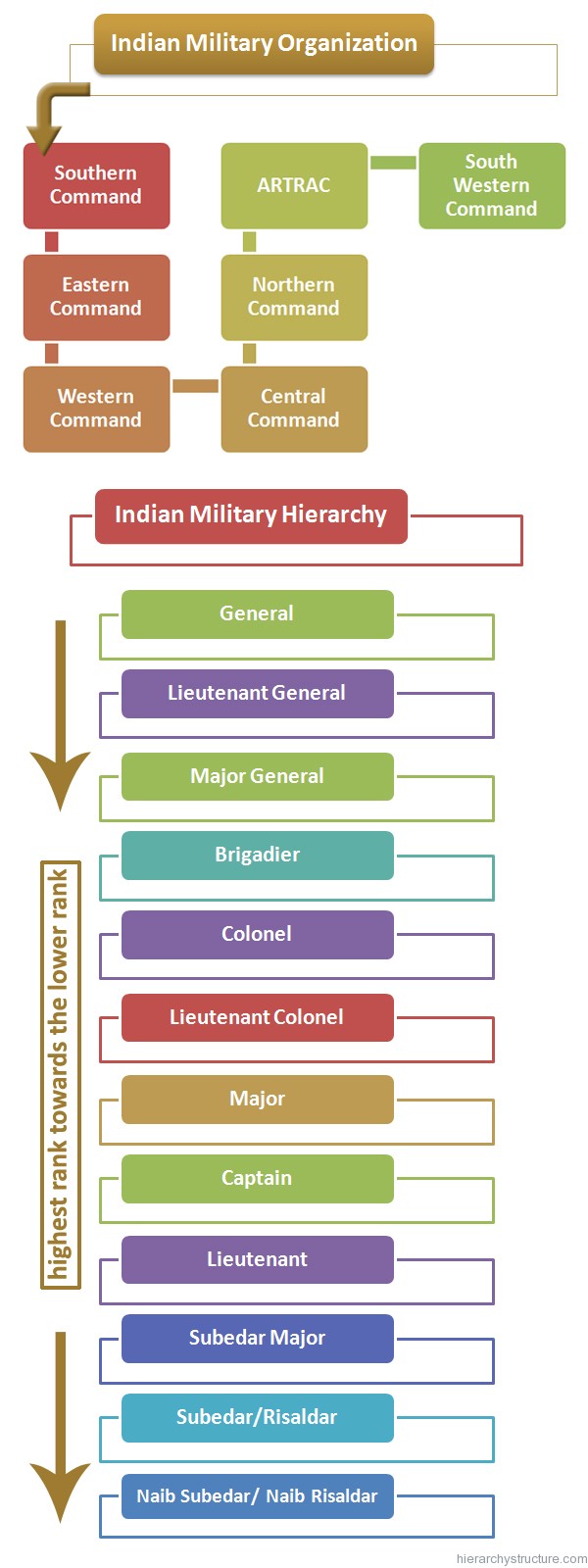Broadly speaking, the Indian military organization is divided into seven commands such as the Southern command, Eastern command, Western command, Central command, Northern command, ARTRAC and South Western command. In this particular article, we will take a brief look at all the commands and will discuss in details about the different positions of the Indian military hierarchy.

Southern Command
The southern command comprises of two corps such as 12 and 21, located at Jodhpur and Bhopal. The southern command includes nine states and four union territories. Most of the technical, medical, sports and defense research and development establishments are under this command.
Eastern Command
The eastern command is headquartered at Fort William, Kolkata of state West Bengal and encompasses the states such as Sikkim, Arunachal Pradesh, Assam, West Bengal, Nagaland, Manipur, Mizoram, Meghalaya and Tripura.
Western Command
The western command was previously known as a DEP command with its headquarters in Delhi. The command accounts for the defense of Delhi and areas of East Punjab.
Central Command
Headquartered in Lucknow, the central command covers seven states namely Uttaranchal, Uttar Pradesh, Bihar, Jharkhand, Orissa, Madhya Pradesh and Chhattisgarh. There are 18 regimental centers included in the central command.
Northern Command
The northern command includes the state of Jammu and Kashmir and aims at maintaining the territorial integrity of the country.
ARTRAC
The Army Training Command or ARTRAC was established at Madhya Pradesh on 1st October 1991 and was shifted to Shimla on 31st March 1993. ARTRAC acts as a nodal agency for all the institutional training given in the Army.
South Western Command
The south western command started its operation at the Jaipur military station on 15th August.
Now that we are clear about all the commands of the Indian military organization, let’s take a look at the Indian military hierarchy starting from the highest rank towards the lower rank.
General
The insignia of a General is composed of a gold national emblem and a gold star placed above a crossed gold baton and scimitar, all outlined in red. This is the highest rank of the Indian military hierarchy.
Lieutenant General
The insignia of a Lieutenant General is a gold national emblem placed above a crossed gold baton and scimitar, all outlined in red.
Major General
The insignia of a Major General is a gold star outlined in red, placed above a crossed gold baton and scimitar outlined in red.
Brigadier
The insignia of a Brigadier is a gold national emblem over three gold stars in a triangle position.
Colonel
The insignia of a Colonel is a gold national emblem, placed over two gold stars.
Lieutenant Colonel
The insignia of a Lieutenant Colonel is a gold national emblem over a single gold star.
Major
The insignia of a Major is a single gold national emblem.
Captain
The insignia of a Captain consists of three gold stars.
Lieutenant
The insignia of a Lieutenant consists of two gold stars.
Subedar Major/ Risaldar Major
The insignia of a Subedar Major consists of a gold national emblem with stripe.
Subedar/Risaldar
The insignia of a Subedar consists of two gold stars with stripe.
Naib Subedar/ Naib Risaldar
The insignia of a Naib Subedar consists of one gold star with the stripe.
Know about Indian Police Service Hierarchy.
